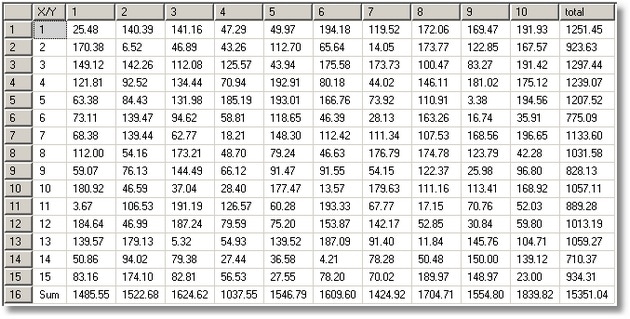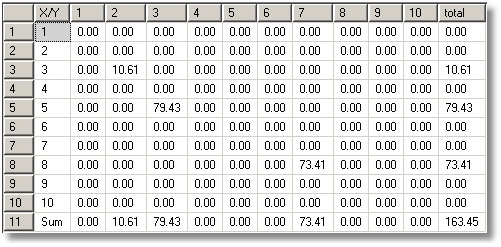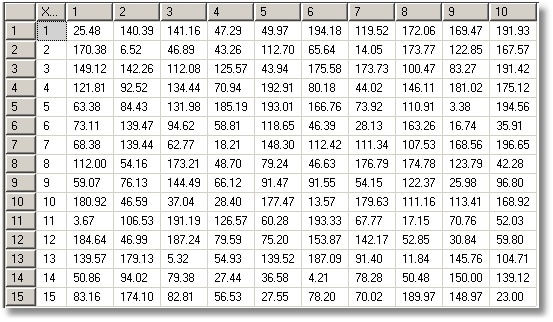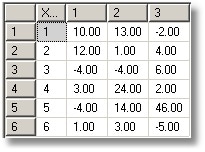I think that we need to lay to rest the idea that you cannot do matrix operations in SQL. They are just as easy as they are in a procedural language. One just needs a clear head and think in terms of set-based operations.
If you’re not aware of the usefulness of matrix operations, then you’ll be surprised. They underlie a lot of linear equations and statistics (We do a cool Orthogonal Factor Analysis in SQL!). They’re used a lot in games programming, and bitmap manipulation. We tend to use them for sticky SQL problems such as reserving seats or timetabling. Once you’ve started, you’ll find a lot of SQL problems that can be solved with matrices. (Just in case the formatting goes awry, we’re including the SQL Source file in the downloads at the bottom of the article.) Please remember that this isn’t production-quality code: as in all of our workbenches, we’re keeping things simple to illustrate the points as clearly as we can.
We’ll create a table to store two-dimensional arrays that contain an exact number with two digits precision. You’ll see that we can create any number of matrixes in this array, which cuts down on the chore of creating tables. It also means that functions and procedures can be hardwired to a common matrix table. Of course, you would create the ‘element’ type according to your data.
|
1 2 3 4 5 6 7 8 |
IF OBJECT_ID ( N'matrix' ) IS NOT NULL DROP TABLE matrix CREATE TABLE matrix ( [Name] VARCHAR ( 10 ), x INT NOT NULL, y INT NOT NULL, element NUMERIC ( 9 , 2 ) NOT NULL PRIMARY KEY ( [name] , x , y )) |
Yes, this allows the use of sparse arrays, but you would usually need to handle gaps. Note the compound primary key. This automatically prevents duplication of data in a cell (try it in order to convice yourself) and provides a reasonable index for most operations. If you use very large matrixes, you will need to provide an extra covering index.
Now let’s fill matrix ‘A’ with some spoof data so we can just do some simple stuff such as summing the rows and columns.
We’ll choose a ten by fifteen matrix:
|
1 2 3 4 5 6 7 8 9 10 11 12 13 |
SET NOCOUNT ON --cut down on the badinage DELETE FROM matrix WHERE [Name] = 'A' DECLARE @ii INT , @jj INT SELECT @ii = 1 , @jj = 1 WHILE @ii <= 10 -- loop around as if we were C# programmers! BEGIN WHILE @jj <= 15 BEGIN INSERT INTO matrix SELECT 'A' , @ii , @jj , RAND ()* 200 SELECT @jj = @jj + 1 END SELECT @jj = 1 , @ii = @ii + 1 END |
Now the simple way to do a summation is by using the built-in grouping functions such as ROLLUP and CUBE:
|
1 2 3 4 5 6 7 8 9 10 11 12 13 14 15 16 17 |
SELECT [X/Y] = CASE WHEN GROUPING ( y ) = 0 THEN CAST ( y AS VARCHAR ( 6 )) ELSE 'Sum' END , '1' = SUM ( CASE WHEN x = 1 THEN element ELSE 0 END ), '2' = SUM ( CASE WHEN x = 2 THEN element ELSE 0 END ), '3' = SUM ( CASE WHEN x = 3 THEN element ELSE 0 END ), '4' = SUM ( CASE WHEN x = 4 THEN element ELSE 0 END ), '5' = SUM ( CASE WHEN x = 5 THEN element ELSE 0 END ), '6' = SUM ( CASE WHEN x = 6 THEN element ELSE 0 END ), '7' = SUM ( CASE WHEN x = 7 THEN element ELSE 0 END ), '8' = SUM ( CASE WHEN x = 8 THEN element ELSE 0 END ), '9' = SUM ( CASE WHEN x = 9 THEN element ELSE 0 END ), '10' = SUM ( CASE WHEN x = 10 THEN element ELSE 0 END ), 'total' = SUM ( element ) FROM matrix WHERE [name] = 'a' GROUP BY y WITH ROLLUP ORDER BY GROUPING ( y ), y |

Note that, if you are using sparse arrays, you may need to do this.
First, we’ll put in a few drips and drabs of data.
|
1 2 3 4 5 6 7 8 9 10 11 12 13 14 15 16 17 18 19 20 21 22 23 24 |
DELETE FROM matrix WHERE [name] = 'z' INSERT INTO matrix SELECT 'z' , 3 , 5 , RAND ()* 200 INSERT INTO matrix SELECT 'z' , 7 , 8 , RAND ()* 200 INSERT INTO matrix SELECT 'z' , 2 , 3 , RAND ()* 200 SELECT [X/Y] = CASE WHEN GROUPING ( ydimension.number ) = 0 THEN CAST ( ydimension.number AS VARCHAR ( 6 )) ELSE 'Sum' END , '1' = SUM ( CASE WHEN x = 1 THEN element ELSE 0 END ), '2' = SUM ( CASE WHEN x = 2 THEN element ELSE 0 END ), '3' = SUM ( CASE WHEN x = 3 THEN element ELSE 0 END ), '4' = SUM ( CASE WHEN x = 4 THEN element ELSE 0 END ), '5' = SUM ( CASE WHEN x = 5 THEN element ELSE 0 END ), '6' = SUM ( CASE WHEN x = 6 THEN element ELSE 0 END ), '7' = SUM ( CASE WHEN x = 7 THEN element ELSE 0 END ), '8' = SUM ( CASE WHEN x = 8 THEN element ELSE 0 END ), '9' = SUM ( CASE WHEN x = 9 THEN element ELSE 0 END ), '10' = SUM ( CASE WHEN x = 10 THEN element ELSE 0 END ), 'total' = COALESCE ( SUM ( element ), 0 ) FROM ( SELECT number FROM numbers WHERE number <= 10 ) ydimension LEFT OUTER JOIN matrix ON ydimension.number = y AND name = 'z' GROUP BY ydimension.number WITH ROLLUP ORDER BY GROUPING ( ydimension.number ), ydimension.number |

If this is tedious, then use a procedure. Well, of course it’s tedious!
|
1 2 3 4 5 6 7 8 9 10 11 12 13 14 15 16 17 18 19 20 21 22 23 |
IF OBJECT_ID ( N'AggregateMatrix' ) IS NOT NULL DROP PROCEDURE AggregateMatrix GO CREATE PROCEDURE AggregateMatrix @Name VARCHAR ( 5 ) = 'A' , @Aggregation VARCHAR ( 10 ) = 'SUM' AS DECLARE @ii INT , @Max INT , @SQL VARCHAR ( 8000 ) SELECT @ii = 1 , @max = MAX ( x ) FROM matrix WHERE [name] = @Name SELECT @SQL = 'Select [X/Y]=case when grouping(y)=0 then cast(y as varchar(6)) else '''n> + @Aggregation + ''' end, ' WHILE @ii <= @max SELECT @SQL = @SQL + '''' + CAST ( @ii AS VARCHAR ( 5 )) + '''=' + @Aggregation + '(case when x=' + CAST ( @ii AS VARCHAR ( 5 )) + ' then element else 0 end),' , @ii = @ii + 1 SELECT @SQL = @SQL + '''total''=' + @Aggregation + '(element) from matrix where [name]=''' + @name + ''' group by y with rollup order by grouping(y),y' EXECUTE ( @SQL ) IF @@error > 0 PRINT @SQL GO |
And while we’re about it, we’ll add a procedure to do a simple matrix. This will just be a cut-down version of the one above.
|
1 2 3 4 5 6 7 8 9 10 11 12 13 14 15 16 17 18 19 20 |
IF OBJECT_ID ( N'SimpleMatrix' ) IS NOT NULL DROP PROCEDURE SimpleMatrix GO CREATE PROCEDURE SimpleMatrix @Name VARCHAR ( 5 ) = 'A' AS DECLARE @ii INT , @Max INT , @SQL VARCHAR ( 8000 ) SELECT @ii = 1 , @max = MAX ( x ) FROM matrix WHERE [name] = @Name SELECT @SQL = 'Select [X/Y]=cast(y as varchar(6))' WHILE @ii <= @max SELECT @SQL = @SQL + ', ''' + CAST ( @ii AS VARCHAR ( 5 )) + '''=sum(case when x=' + CAST ( @ii AS VARCHAR ( 5 )) + ' then element else 0 end)' , @ii = @ii + 1 SELECT @SQL = @SQL + ' from matrix where [name]=''' + @name + ''' group by y' EXECUTE ( @SQL ) IF @@error > 0 PRINT @SQL GO |
Okay, let’s try them out!
|
1 |
EXECUTE SimpleMatrix 'a' |

In order to do a few common matrix examples, we need to devise a few helper functions to allow us to get matrix data in there easily, in the format that is easy to check for errors. This is very handy when you are doing regression testing.
Before we do the routine, let’s just make sure you have a number table…
|
1 2 3 4 5 6 7 8 9 10 11 12 13 14 15 16 17 18 19 20 21 22 23 24 25 26 27 28 29 |
IF OBJECT_ID ( N'spMaybeBuildNumberTable' ) IS NOT NULL DROP PROCEDURE spMaybeBuildNumberTable GO CREATE PROCEDURE spMaybeBuildNumberTable @size INT= 10000 --or whatever size you want to have for your number table AS BEGIN SET NOCOUNT ON IF NOT EXISTS ( SELECT * FROM dbo.sysobjects --check to make sure you have one WHERE id = OBJECT_ID ( N'[dbo].[Numbers]' ) AND OBJECTPROPERTY ( id , N'IsUserTable' ) = 1 ) BEGIN --create it and stock it. CREATE TABLE [dbo].[Numbers] ( [number] [int] , CONSTRAINT [Index_Numbers] PRIMARY KEY CLUSTERED ( [number] ASC ) ON [PRIMARY] ) ON [PRIMARY] --right lets stock it. Jeff would hate this code. DECLARE @ii INT SELECT @ii = 1 WHILE ( @ii <= @size ) BEGIN INSERT INTO NUMBERS ( NUMBER ) SELECT @II SELECT @II = @II + 1 END END END |
Now we can add the function that takes a string representation of a matrix, just like you see in the textbooks, and returns the SQL equivalent (please try it out just to see what it does). It could be done iteratively, but we have opted for the must faster TSQL-Special technique. If you are using a different dialect, you’ll have to do it the slow iterative way instead, but we’re using SQL Server!
|
1 2 3 4 5 6 7 8 9 10 11 12 13 14 15 16 17 18 19 20 21 22 23 24 25 26 27 28 29 30 31 32 33 34 35 36 37 38 39 40 |
GO IF OBJECT_ID ( N'dbo.MatrixValuesOf' ) IS NOT NULL DROP FUNCTION dbo.MatrixValuesOf GO CREATE FUNCTION dbo.MatrixValuesOf ( @Matrix VARCHAR ( MAX ), @Name VARCHAR ( 10 ) ) RETURNS @MatrixValues TABLE ( -- columns returned by the function name VARCHAR ( 10 ) NOT NULL, x INT NOT NULL, y INT NOT NULL, [Value] NUMERIC ( 8 , 2 ) ) AS BEGIN DECLARE @y INT , @x INT , @Value VARCHAR ( 200 ) DECLARE @MyTable TABLE ( TheOrder INT PRIMARY KEY , TheChar CHAR ( 1 ) NOT NULL, x INT , y INT , Thevalue NUMERIC ( 8 , 2 ), strvalue VARCHAR ( 200 )) SELECT @x = 1 , @y = 1 , @Value = '' INSERT INTO @MyTable ( TheOrder , TheChar ) SELECT number , SUBSTRING ( @Matrix , number , 1 ) FROM numbers WHERE number <= LEN ( @Matrix ) UPDATE @MyTable SET @x = x = CASE WHEN TheChar = ',' THEN @x + 1 WHEN TheChar =CHAR ( 13 ) THEN 1 ELSE @x END , @y = y = CASE WHEN TheChar =CHAR ( 13 ) THEN @y + 1 ELSE @y END , @value = strvalue = CASE WHEN TheChar IN ( ',' , CHAR ( 13 )) THEN '' WHEN '1234567890-+.' LIKE '%' + theChar + '%' THEN @value + TheChar ELSE @value END INSERT INTO @MatrixValues SELECT @Name , x , y , CAST ( RTRIM ( LTRIM ( CASE WHEN ISNUMERIC ( strValue ) = 1 THEN strValue ELSE '0' END )) AS NUMERIC ( 8 , 2 )) FROM @MyTable WHERE TheOrder IN ( SELECT MAX ( TheOrder ) FROM @MyTable GROUP BY x , y ) RETURN END GO |
So let’s test it out now….
|
1 2 3 4 5 6 |
DECLARE @matrixA VARCHAR ( 2000 ) SELECT @MatrixA = '2, 34, 67.78 4, 5, 7 5, 457, 8.65' SELECT * FROM MatrixValuesOf ( @MatrixA , 'a' ) |
Wee!! that worked, didn’t it!
|
1 2 3 4 5 6 7 8 9 10 11 12 13 |
/* name x y Value ---------- ----------- ----------- -------- a 1 1 2.00 a 2 1 34.00 a 3 1 67.78 a 1 2 4.00 a 2 2 5.00 a 3 2 7.00 a 1 3 5.00 a 2 3 457.00 a 3 3 8.65 */ |
Let’s double-check…
|
1 2 3 4 5 6 7 8 9 10 |
DELETE FROM matrix WHERE [Name] = 'Z' INSERT INTO matrix SELECT * FROM MatrixValuesOf ( '5.31, 1.54, 0.09, 3.60, 8.64, 1.01, 8.05, 3.59, 2.61, 8.59 4.61, 2.29, 9.16, 4.19, 8.17, 0.29, 6.92, 9.96, 9.00, 3.68 8.56, 9.67, 6.40, 4.25, 2.39, 7.30, 0.42, 2.62, 3.73, 2.54 8.86, 6.47, 1.06, 6.98, 3.54, 1.05, 2.93, 1.85, 4.35, 4.11 4.14, 1.64, 2.35, 2.11, 6.08, 6.52, 3.07, 9.62, 0.67, 8.32' , 'z' ) EXECUTE SimpleMatrix 'z' |

Now we can get started!
Matrix multiplication by a scalar
|
1 2 3 4 5 6 7 8 9 10 11 |
DELETE FROM matrix WHERE [Name] = 's' INSERT INTO matrix SELECT * FROM MatrixValuesOf ( ' 4, 5, -56 14, 11, 43 -43, -4, 62' , 's' ) INSERT INTO matrix SELECT 't' , x , y , element * 2 FROM matrix s WHERE s.[name] = 's' |
And let’s see the result….
|
1 |
EXECUTE SimpleMatrix 't' |
So scalar arithmetic is absurdly simple and need concern us no longer.

Matrix Addition
Here is how we do Matrix Addition.
|
1 2 3 4 5 6 7 8 9 10 11 12 13 14 15 16 17 18 19 20 21 22 23 24 25 26 27 |
--pop in Matrix A DELETE FROM matrix WHERE [Name] = 'a' INSERT INTO matrix SELECT * FROM MatrixValuesOf ( '10, 13, -2 12, 1, 4 -4, -4, 6' , 'a' ) --add in Matrix B DELETE FROM matrix WHERE [Name] = 'b' INSERT INTO matrix SELECT * FROM MatrixValuesOf ( ' 3, 24, 2 -4, 14, 46 1, 3, -5' , 'b' ) --now create a matrix 'c' which is the matrix addition of A and B DELETE FROM matrix WHERE [Name] = 'c' INSERT INTO matrix SELECT 'c' , a.x , a.y , a.element + b.element FROM matrix a INNER JOIN matrix b ON a.x = b.x AND a.y = b.y WHERE a.[name] = 'a' AND b.[name] = 'b' |
And let’s see the result….
|
1 2 3 4 5 6 7 8 9 |
EXECUTE SimpleMatrix 'c' /* X/Y 1 2 3 ------ ------------- ------------- ------------- 1 13.00 37.00 0.00 2 8.00 15.00 50.00 3 -3.00 -1.00 1.00 */ |
Matrix subtraction
And matrix subtraction is just as easy.
|
1 2 3 4 5 6 7 8 |
DELETE FROM matrix WHERE [Name] = 'd' INSERT INTO matrix SELECT 'd' , a.x , a.y , a.element - b.element FROM matrix a INNER JOIN matrix b ON a.x = b.x AND a.y = b.y WHERE a.[name] = 'a' AND b.[name] = 'b' |
And now let’s see it!
|
1 2 3 4 5 6 7 8 9 |
EXECUTE SimpleMatrix 'd' /* X/Y 1 2 3 ------ ------------- ------------- ------------- 1 7.00 -11.00 -4.00 2 16.00 -13.00 -42.00 3 -5.00 -7.00 11.00 */ |
Matrix Multiplication
So you think you can do the same thing with matrix multiplication eh? Just use a ‘*’ instead of a ‘-‘? Think again. this is where it gets more complicated.
We’ll multiply two nice simple matrices…
|
1 2 3 4 5 6 7 8 9 10 11 12 13 14 15 16 17 18 19 20 21 22 23 24 25 26 27 |
DELETE FROM matrix WHERE name IN ( 'e' , 'f' ) INSERT INTO matrix SELECT * FROM MatrixValuesOf ( ' 1, 2, 3 4, 5, 6' , 'e' ) INSERT INTO matrix SELECT * FROM MatrixValuesOf ( ' 7, 8 9, 10 11,12' , 'f' ) /* create the result of the matrix multiplication */ INSERT INTO matrix SELECT 'g' , xf , ye , SUM ( ee * ef ) FROM ( SELECT [ee] = e.element , [ef] = f.element , [xe] = e.x , [ye] = e.y , [xf] = f.x , [yf] = f.y FROM matrix e INNER JOIN Matrix f ON e.x = f.y WHERE e.[name] = 'e' AND f.[name] = 'f' ) pairs GROUP BY ye , xf EXECUTE SimpleMatrix 'g' |

Matrix Horizontal concatenation
Horizontal concatenation is cool.
|
1 2 3 4 5 6 7 8 9 10 11 12 13 14 15 16 17 18 19 20 21 22 23 24 25 |
--pop in Matrix A DELETE FROM matrix WHERE [Name] = 'a' INSERT INTO matrix SELECT * FROM MatrixValuesOf ( '10, 13, -2 12, 1, 4 -4, -4, 6' , 'a' ) --add in Matrix B DELETE FROM matrix WHERE [Name] = 'b' INSERT INTO matrix SELECT * FROM MatrixValuesOf ( ' 3, 24, 2 -4, 14, 46 1, 3, -5' , 'b' ) --now create a matrix 'c' which is A and B concatenated ( normally, you'd put the MAX value into a variable, of course but we wanted to keep it simple) DELETE FROM matrix WHERE [Name] = 'c' INSERT INTO matrix SELECT 'c' , [x] = CASE name WHEN 'a' THEN x ELSE x +( SELECT MAX ( x ) FROM matrix WHERE [name] = 'a' ) END , y , element FROM matrix t WHERE t.[name] IN ( 'a' , 'b' ) EXECUTE SimpleMatrix 'c' |

Matrix Vertical Concatenation
Or we can do it vertically (sentiment about the variable applies here too).
|
1 2 3 4 5 6 |
DELETE FROM matrix WHERE [Name] = 'c' INSERT INTO matrix SELECT 'c' , [x] = x , [y] = CASE name WHEN 'a' THEN y ELSE y +( SELECT MAX ( y ) FROM matrix WHERE [name] = 'a' ) END , element FROM matrix t WHERE t.[name] IN ( 'a' , 'b' ) EXECUTE SimpleMatrix 'c' |

Matrix Transposition
Fine, so how do we do Matrix transposition?
|
1 2 3 4 5 6 7 8 9 10 11 12 |
DELETE FROM matrix WHERE [Name] = 't' INSERT INTO matrix SELECT * FROM MatrixValuesOf ( '1, 2, 3 4, 5, 6' , 't' ) DELETE FROM matrix WHERE [Name] = 'u' INSERT INTO matrix SELECT 'u' , [x] = y , [y] = x , element FROM matrix t WHERE t.[name] = 't' EXECUTE SimpleMatrix 'u' --and display the transposed matrix |

Rendering a matrix as a string
So now, just to finish off with a flourish, we’ll reverse-out our MatrixValuesOf Function, so we can represent the results in a string. This means that we could make an easier test harness and could squirrel matrixes away in string form.
|
1 2 3 4 5 6 7 8 9 10 11 12 13 14 15 16 17 18 19 20 21 22 23 24 25 26 27 28 29 30 31 32 33 34 35 36 37 38 39 40 41 42 43 44 45 46 47 48 49 50 51 52 53 54 55 56 57 58 59 60 61 62 63 64 65 66 67 68 69 70 |
IF OBJECT_ID ( N'StringMatrix' ) IS NOT NULL DROP PROCEDURE StringMatrix GO CREATE PROCEDURE StringMatrix @Name VARCHAR ( 5 ) = 'A' , @String VARCHAR ( MAX ) OUTPUT AS SET NOCOUNT ON DECLARE @ii INT , @Max INT , @SQL NVARCHAR ( 4000 ) SELECT @ii = 1 , @max = MAX ( x ) FROM matrix WHERE [name] = @Name WHILE @ii <= @max SELECT @SQL = COALESCE ( @SQL + ' +' , 'Select @string=coalesce(@String,'''')+' )+ 'right('' ''+cast(cast(sum(case when x=' + CAST ( @ii AS VARCHAR ( 5 )) + ' then element else 0 end) as numeric(9,2)) as varchar(12)),10)' + CASE WHEN @ii < @max THEN '+'',''' ELSE '+'' ''' END , @ii = @ii + 1 SELECT @SQL = @SQL + ' from matrix where [name]=''' + @name + ''' group by y' EXECUTE sp_ExecuteSQL @SQL , N' @String varchar(max) output' , @String = @String OUTPUT IF @@error > 0 PRINT @SQL GO DECLARE @String VARCHAR ( MAX ) EXECUTE StringMatrix 'a' , @String OUTPUT SELECT @String /* 10.00, 13.00, -2.00 12.00, 1.00, 4.00 -4.00, -4.00, 6.00 So we are ready for a more exacting test... */ DELETE FROM matrix WHERE [Name] = 'x' INSERT INTO matrix SELECT * FROM MatrixValuesOf ( ' 192.96, -55.82, 92.33, 55.86, 58.47, 11.05, 53.26 192.08, 177.95, 167.00, 196.71, 79.70, 91.51, 58.13 12.00, 54.32, 104.72, 63.03, 183.26, 169.45, 117.58 102.87, 189.95, 19.50, 170.58, 0.01, 80.48, 146.79 171.93, 62.35, 88.21, 54.73, 91.39, 151.02, 175.50 44.19, 150.64, 196.40, 17.24, 133.31, 102.52, 146.05 199.20, 190.81, -38.56, 53.04, 47.94, 178.62, 48.57 104.10, 41.95, 175.17, -100.81, 28.55, 82.87, 38.74 126.57, 26.02, 20.88, 59.68, 82.01, 92.68, 119.01 184.44, 27.17, 85.33, 139.79, 123.22, 112.38, 38.28 195.55, 3.82, 170.43, 170.51, 149.36, 118.25, 78.22 135.32, 36.93, 28.97, -111.45, 168.44, 68.15, 189.48 84.04, 107.10, 19.77, 3.20, 69.30, 175.64, 29.29 16.90, 42.28, 73.41, 154.76, 81.55, 57.64, 96.12 66.61, 37.63, 62.82, 87.71, 102.84, 110.43, 185.25' , 'x' ) GO DECLARE @String VARCHAR ( MAX ) EXECUTE StringMatrix 'x' , @String OUTPUT SELECT @String /* which produces this! (phew) 192.96, -55.82, 92.33, 55.86, 58.47, 11.05, 53.26 192.08, 177.95, 167.00, 196.71, 79.70, 91.51, 58.13 12.00, 54.32, 104.72, 63.03, 183.26, 169.45, 117.58 102.87, 189.95, 19.50, 170.58, 0.01, 80.48, 146.79 171.93, 62.35, 88.21, 54.73, 91.39, 151.02, 175.50 44.19, 150.64, 196.40, 17.24, 133.31, 102.52, 146.05 199.20, 190.81, -38.56, 53.04, 47.94, 178.62, 48.57 104.10, 41.95, 175.17, -100.81, 28.55, 82.87, 38.74 126.57, 26.02, 20.88, 59.68, 82.01, 92.68, 119.01 184.44, 27.17, 85.33, 139.79, 123.22, 112.38, 38.28 195.55, 3.82, 170.43, 170.51, 149.36, 118.25, 78.22 135.32, 36.93, 28.97, -111.45, 168.44, 68.15, 189.48 84.04, 107.10, 19.77, 3.20, 69.30, 175.64, 29.29 16.90, 42.28, 73.41, 154.76, 81.55, 57.64, 96.12 66.61, 37.63, 62.82, 87.71, 102.84, 110.43, 185.25 |
So, what goes in comes out (it took a little bit of heaving and grunting). So this is as far as we’ll take it in this workbench and we’ll leave you to figure out a few little puzzles such as inversion and determinants. Now, the next puzzle is how one can use these techniques to solve other programming puzzles. It would be fascinating to learn how this sort of technique can be used.







Load comments